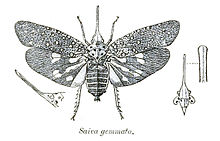
The family Fulgoridae is a large group of hemipteran insects, especially abundant and diverse in the tropics, containing over 125 genera worldwide. They are mostly of moderate to large size, many with a superficial resemblance to Lepidoptera due to their brilliant and varied coloration. Various genera and species are sometimes referred to as lanternflies or lanthorn flies, though they do not emit light.
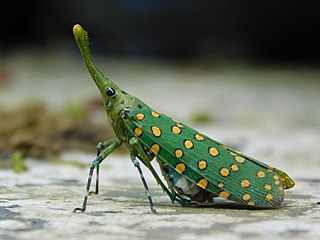
Saiva is a genus of Asian planthoppers, family Fulgoridae. They are colourful insects, marked boldly in red, blue, white and black, with a prominent slender stalk like structure arising on the head that points upwards or forward. The known distribution is from India, through Indo-China to Borneo.

A planthopper is any insect in the infraorder Fulgoromorpha, in the suborder Auchenorrhyncha, a group exceeding 12,500 described species worldwide. The name comes from their remarkable resemblance to leaves and other plants of their environment and that they often "hop" for quick transportation in a similar way to that of grasshoppers. However, planthoppers generally walk very slowly. Distributed worldwide, all members of this group are plant-feeders, though few are considered pests. The infraorder contains only a single superfamily, Fulgoroidea. Fulgoroids are most reliably distinguished from the other Auchenorrhyncha by two features; the bifurcate ("Y"-shaped) anal vein in the forewing, and the thickened, three-segmented antennae, with a generally round or egg-shaped second segment (pedicel) that bears a fine filamentous arista.
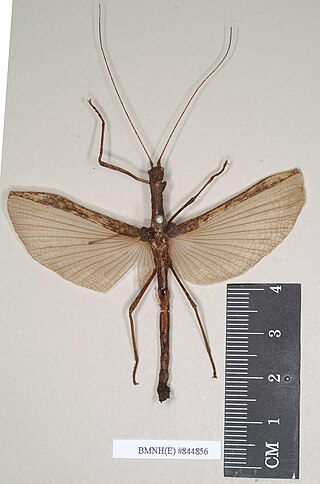
Sosibia is an Asian genus of stick insects in the family Lonchodidae and subfamily Necrosciinae.

Odontoptera is a genus of planthoppers in the family Fulgoridae: from Central and South America.

Lycorma is a genus of planthoppers native to Asia. The first species within the genus was described by Frederick William Hope in 1843 and the genus was formally established by Carl Stål in 1863.

The Fulgorinae are a sub-family of insects in the Auchenorrhyncha: which include the spectacular "lantern-bugs" and allied insects.
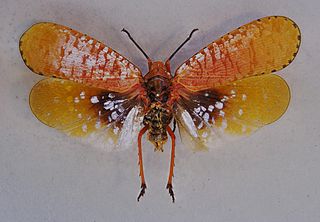
Aphaena is a genus of planthoppers in the sub-family Aphaeninae of Fulgoridae. Species are distributed from eastern India, Indo-China, China and Malesia.

Polydictya is a genus of planthoppers in the sub-family Poiocerinae Haupt, 1929. Species are distributed from India, through Indo-China, to Malesia.
Aphrodisias is a Central American genus of planthoppers in the family Fulgoridae.
Saiva cardinalis is a species of lantern bug in the genus Saiva, found to the North-East of India, Nepal and Vietnam. No subspecies are listed in the Catalogue of Life.
Scambophyllum is a genus of bush cricket in the subfamily Phaneropterinae. Species can be found mostly in Indo-China and Malesia.
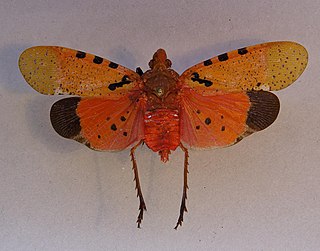
Belbina is a genus of planthoppers in the subfamily Enchophorinae (Fulgoridae): erected by Carl Stål in 1863; species can be found in Madagascar.
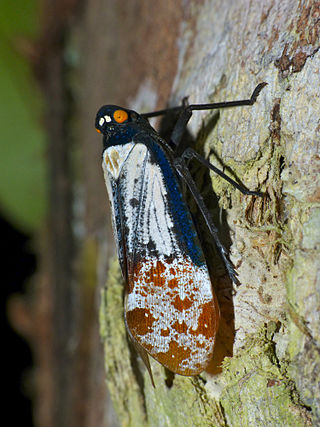
Penthicodes farinosus is a species of planthoppers in the subfamily Aphaeninae (Fulgoridae): with five subspecies distributed in Indo-China and Malesia. The genus name was formerly treated as feminine, but in 2022 it was revised to masculine in accordance with ICZN Article 30.1.4.4, changing the spelling of this species' name from farinosa to farinosus.

Oxyartes is a genus of stick insects in the family Lonchodidae and tribe Necrosciini; species records are from India through to Indochina.

Trachythorax is an Asian genus of stick insects in the family Lonchodidae and subfamily Necrosciinae. Species have been recorded from the Indian subcontinent, Indo-China, Malesia through to New Guinea.

Lopaphus is an Asian genus of stick insects in the tribe Necrosciini. Species have been recorded from India, China and South-East Asia.
Tirachoidea is an Asian genus of stick insects in the family Phasmatidae and tribe Pharnaciini. Species have a known distribution from India, Indochina and West Malesia.
Typhoptera is an Asian genus of bush-crickets in the tribe Cymatomerini and the subfamily Pseudophyllinae. Species are recorded from India, Indo-China and Malesia.

Lycorma imperialis is a planthopper indigenous to parts of China and Indo-Malaysia. L. imperialis was originally discovered in 1846 by Adam White and has one recognized non-nominate subspecies, L. i. punicea. L. imperialis has undergone a number of reclassifications since its discovery and is one of four species in the genus Lycorma. L. imperialis follows a hemimetabolous life cycle and will undergo a series of nymphal stages (instars) before maturing to an adult.
